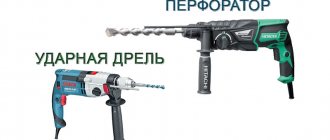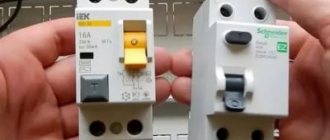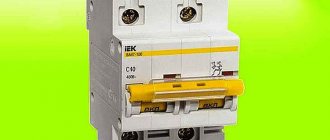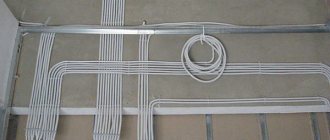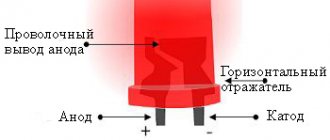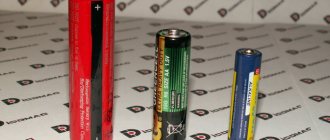Everyone knows the Phillips screwdriver. Many people know that they differ in size, and if the size of the screw and the bit do not match, then when screwing in they can be torn off. But not everyone knows that Phillips screwdrivers are divided into two types:
- Phillips (PH);
- Pozidriv (PZ).
Of course, these are not all types of splines, there are several dozen of them, but the rest are rarely used:
Types of screwdrivers.
PH is a standard Phillips screwdriver. The PZ has additional serrations and a different tip shape. The PZ provides a stronger grip and is gradually replacing the outdated Phillips tip.
Philips has two slots that are located at right angles to each other. Its main disadvantage is the risk of damage to the screws, since the force is adjusted in a narrow area.
Pozidriv is an improved Phillips profile. Its difference lies in the additional cross, narrower and less deep. This shape fits into the fastener better, and the risk of thread breakage is reduced several times.
Of course, you can drive screws with any screwdriver, but due to the different shape of the tip and slot, the tool will sit unevenly and there will be backlash. Because of this, the risk of breaking the screw increases, the bit deteriorates faster, and the quality and speed of work decreases. When using the right screwdriver, it's easy to immediately feel the difference.
It is very easy to distinguish between PH and PZ screws. PZ has additional notches, but PH does not.
Screwdrivers and bits are even easier to distinguish. When purchasing, the type of tip is always indicated on the price tag or packaging.
In addition, the type, size and length of the working part are often already indicated on the screwdriver itself.
The designation PH1x80mm makes it clear that you are holding a screwdriver with a Phillips tip of the first size and a long working part of 80 mm. The first and second sizes are most often used.
The PZ has virtually no bevel on the cross, while the PH has it at an angle.
Video instruction:
How to choose a quality screwdriver
You shouldn’t expect good metal and an ergonomic handle from cheap products; it’s better to initially choose screwdrivers from well-known brands. This is 2-3 times more expensive, but then you can use one screwdriver for many years, which is better than changing Chinese products every six months. The screwdriver should fit comfortably in your hand and not press on your palm. Even the slightest inconvenience during the work process can reward you with bloody blisters. When applying a lot of force, a low-quality steel screwdriver will quickly lose its shape and begin to spin on the slot of the screw head. It is quite difficult to check the quality of steel when purchasing; usually, the more comfortable the handle, the higher the quality of the steel. The price is appropriate.
Types and types of bits
PH - (Phillips standard)
The PH standard is a Phillips spline with an apex angle of 55°. Each of the four splines has an extension towards the shank.
Bits marked PH can have different slot diameters and are marked from the small PH 0, designed for small diameter screws, to PH3, capable of holding large screws.
Bits marked PH 2 are the most common, as they are used for tightening so-called self-tapping screws for thin metal, or (black) self-tapping screws that have a simple cross-shaped slot in the head.
The PH standard is more universal and can be used with other screws.
PZ - (Pozidriv standard)
This standard is suitable for self-tapping screws that have slots in the Pozi standard head. The Pozidriv standard is a kind of improved version of the previous type of bit. PZ bit - represents a cross-shaped slot, having the same thickness of each edge with an apex angle of 50°. A significant difference between the PZ bit is the “double cross”. The placement of additional small splines between the main splines made it possible to increase the holding force of the bits. PZ standard bits are also available in different sizes and can be marked PZ1, PZ2, PZ3. PZ standard bits are used for such self-tapping screws as UP (universal countersunk), which has an average thread pitch, as well as for other self-tapping screws with a Pozi slot.
SL - (Slot - Straight slot)
The well-known flat spline also has its own marking, such a bit is called SL.
The SL standard is a straight spline (flat) that can have different widths.
The width in millimeters is indicated after the SL marking - for example, SL 5, from which we understand that we are dealing with a bat that has a flat slot 5mm wide.
Torx - (Six-pointed star)
This slot, when viewed from the end of the bit, is a six-pointed star; the differences lie in the diameter of the star.
The slot number is indicated on the bit and comes after the inscription Torx or simply the letter T, for example Torx 10 - which corresponds to approximately 2.74 mm. Torx has its own numbers for different bit sizes. Torx slots are used where high torque is required when tightening fasteners. Such a slot can be found on powerful self-tapping screws.
In addition to marking the slots, the bit may have a different shaft length or a limiter that will not allow you to turn the screw in the drywall further than necessary.
Screwdriver manufacturers
- Stanley is an American company with production in Thailand. A wide range of screwdrivers of fairly good quality.
- STAYER is a Russian company that produces budget instruments. It produces quite good screwdrivers in its price category.
- Wiha produces premium tools. Screwdrivers from this company are expensive, but high quality
- JONNESWAY is a Taiwanese manufacturer that produces very high quality screwdrivers
- Hama is a company from Germany, production in China. The products of this company are highly reliable
A high-quality screwdriver will last for many years if used correctly. You just have to follow a few simple rules: use a different screwdriver for each screw and do not use the screwdriver as a lever or chisel.
Pozidriv [edit | edit code]
Frearson
- a rather rare and almost forgotten type of slot.
Also known as Reed & Prince
. Similar to Phillips, but has a sharp end and a larger V-shape angle (75°). One advantage over Phillips is that one screwdriver or bit fits all screw sizes. Found in imported marine equipment. The lack of fillets on the cross slot allows for more force to be applied, unlike the rounded conical shapes of Phillips, which were designed to push the tool out at high torque.
Marking bits for screwdrivers
As already noted, there are two commonly used types of bits - Ph and Pz. The first variety is universal. The apex angle is 55°. The most commonly used bit is Ph2.
The Pz attachment is more convenient, but it can only be used for self-tapping screws with notches. In addition to the four main diagonal ribs, it has four smaller ribs that increase the adhesion area with the self-tapping screw. The apex angle of such nozzles is 50°.
There are bits that replace flathead screwdrivers. They are marked as S or Sl. T-bits are used to mount the star section.
conclusions
Let us summarize the difference between the PH2 and PZ2 bits. The first ones are designed for screwing screws into soft material and have only 4 edges. The second ones have 8 edges and are used to screw a self-tapping screw into a hard-to-reach place or into dense material.
It’s easy to understand which bit to choose for a particular piece of hardware: take a closer look at the head. If the groove for the bat has notched rays directed from the center to the edges, use a Podriv bat. Otherwise, use Phillips.
- Choosing the “right” concrete mixer
- How to sharpen a brazed saw blade?
Screwdriver profile Ph
The cross-head slot we are used to was invented back in the 30s. A few years later, the patent for this invention was bought by the enterprising Henry Phillips.
G. Phillips patent for Ph profile
This profile was named in his honor - Ph = Phillips. Just don't confuse the Philips company from the Netherlands (with one L) with the Phillips Screw Company founded in the USA.
We know the first one well from televisions, cassettes, high-quality lighting devices, etc. But the second one gave us variety in threaded fasteners.
At first glance, Ph is a simple cross, narrowed to the base and nothing more. It would seem that there is nothing to invent and patent here?
But this is not true at all. The Ph profile is made strictly at a certain angle of 55 degrees and with an inclination of the side surface of each face.
Thanks to this, if you start tightening screws or screws with extreme force, risking overtightening them, the bit or sting will simply pop out of the head of the screw or screw without damaging the fastener itself.
As you know, this was not done by accident. In this way, a certain tightening torque was achieved when using the tool on flow assemblies of the automotive industry and aircraft manufacturing in the USA.
Subsequently, with the invention of torque ratchets, screwdrivers and screwdrivers, as well as increased requirements for precise tightening torque, this began to work to the detriment.
In practical terms, this means that you don't have to mutilate the Ph bit if it starts popping out of the fastener. It turns out that the limit of the screw's tightening ability has been reached and there is no need to turn it any further.
Features of flat and hex screwdrivers
Types such as hexagonal and flat tools are the most common. They are used for screws and self-tapping screws, for which there are no special requirements. So, the characteristics of a flat screwdriver are as follows:
- the tool fits a flat slot type;
- tightens screws and screws;
- The marking of such a product is marked by the width of the tip:
- The width of the product ranges from 1 to 10 mm depending on the model.
Flat-head screwdrivers are one of the oldest that began to be used for household needs and are still widely used.
The description of the hexagonal fixtures is as follows:
- Hex screwdrivers or inbuses are designed for fasteners with a hex slot.
- The most common type is an L-shaped bent rod with different hexagonal cross-section sizes.
- High torque, significantly exceeding the torque of a Phillips screwdriver.
- Areas of application: repairing electrical equipment and unscrewing fasteners in areas that are energized.
- Hex screwdrivers are labeled HEX, similar to the less popular square-type screwdrivers.
If the tool tips have a six-pointed star cross-section, then they are marked as Torx. Fasteners with such a slot are used for repairing mobile phones and other equipment. Such devices are used exclusively in service centers for repairing equipment and telephones.
Slotted bits
The very first screwdriver to be invented was a slotted screwdriver; it was invented in the 16th century. It was widespread during the Soviet period. Today, there are also types of screwdriver bits made for straight slots, but they are used less frequently. Such bits are designated by the letter S. This marking is placed on one of the edges of the bits. The Latin letter S is an abbreviation for the English word slot, meaning “slit” or “slot.” There is also an alternative designation - slotted. This word when translated into Russian means “slotted”. There is always a number next to the letter indicating the width of the tip. In some cases, its thickness is additionally indicated.
The ratio of the width and thickness of the most common slotted bits:
| Width, mm | 2,0 | 2,5 | 3,0 | 3,5 | 4,0 | 4,5 | 5,0 | 5,5 | 6,0; 6,5; 7,0 | 8,0 | 9,0 |
| Thickness, mm | 0,3 — 0,4 | 0,4 | 0,5 | 0,5 — 0,6 | 0,6 — 0,8 | 0,6 | 0,8 | 0,8 — 1,0 | 1,0 — 1,2 | 1,2 — 1,6 | 1,4 — 1,6 |
Classic straight bit
Width and thickness are the two main dimensions of a straight spline. In most cases, only the first parameter is specified. It varies from 3.0 to 9.0 mm. The second parameter is often not indicated, but its value can range from 0.5 to 1.6 mm. The peculiarity of this marking is due to the fact that the width and thickness have a standard ratio. The surface of the flat-slotted bits is protected from erosion and has increased hardness.
Bit with straight slot and TIN coating
These bits have a golden color because the surface of the bits is coated with titanium nitride as a result of the CVD chemical process. Thanks to this, the devices have a durable surface. Such nozzles may differ from each other only in width. This value ranges from 4.5 to 6.5 mm. The markings of the devices may also indicate their thickness. This value ranges from 0.6 to 1.2 mm.
PH2 bits: description, purpose
Until 1933, screwdrivers with a straight cut (flat) were used in production, which could easily damage parts, and they turned out to be unsuitable for mechanical tightening of screws. The invention of Phillips screws and the same bits was revolutionary. Henry Phillips bought the patent, and the bits began to be called after him - PH or Phillips. Depending on the size, a number from 0 to 3 is added to the marking. PH2 bits are used in everyday life, the features of which are:
- slot in the form of a cross with a bevel angle of 550;
- the ability to screw screws into soft or thin material;
- When working with a screwdriver, upon completion of tightening, the tip of the bit is pushed out.
Despite the apparent convenience, the main drawback quickly became apparent: the lack of strong adhesion to the surface, as a result of which the edges of the bit and screws “lick off.”

